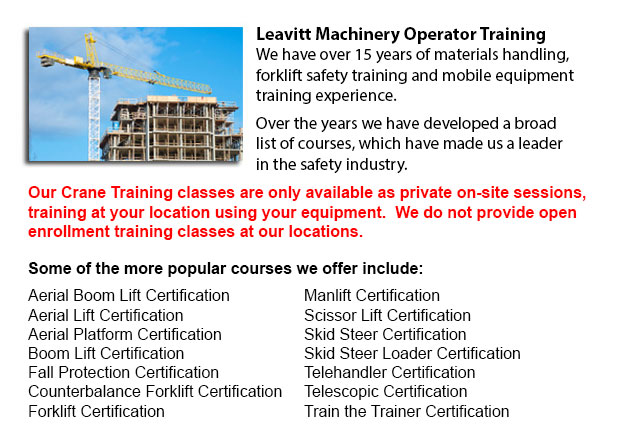
Overhead Crane Safety Training Oakville - Overhead crane safety training equips operators with skills and knowledge regarding crane safety precautions, materials handling, accident avoidance, and machine and stock protection. Trainees will learn the kinds of overhead cranes, their capabilities and their uses in various industry settings. For operators who are licensed and trained, the shift in liability moves to the operator from the company. Hence, the program emphasizes individual operator responsibilities.
Overhead crane safety training instructs operators in the right ways for carrying out inspections. Two types of pre-shift check are the walk-around inspection and the in-depth inspection. These are critical daily routines which should be logged. Correctly recorded pre-shift inspections help to protect the business from liability in case of an accident. Pre-shift inspections likewise prevent damage, costly repairs and accidents. Operators learn how to designate a specific individual to handle inspections, how to maintain the log book and how to report problems.
Checks should be performed often and documented correctly. The following must inspected while watching for usual problems: hooks for cracks, increases in the throat opening, hoist ropes for corrosion, degree of twist, loss of diameter, worn wires, kinks and bird caging, broken wires, chemical and heat damage; chains for gouges and nicks, corrosion and cracks, twists, distortion, excessive wear, stretching, pits, damage from extreme heat.
Operators learn right rigging measures in this program. Rigging includes understanding the manufacturer's data plate, determining the weight of materials to be lifted, choosing the gear, and utilizing safe practices to secure the load. The course include in detail the following: safe working loads, and the capacities of ropes, chains, shackles, slings and hooks.
It is important to know who may utilize the cranes at your facility, the job's physical requirements, and operator credentials required for specialized job and permits. Safety should be prioritized when using in the vicinity of pedestrian traffic.
The duties involved in the safe crane utilization consists of checking for hydraulic leaks, undertaking visual inspections, checking the safety guards, testing the controls, examining the hoist rope and hook, limit switches and braking mechanisms. Right reporting methods are important. These subject matters are all included in depth in the course.
The program also consists of the right lifting and moving procedures with cranes and hoists. Operators will likewise learn right hand signals. Training includes how to attach the load, raise the load, set the load, unhook the slings and abort a lift.
The steps included with moving the load, includes: stopping and starting procedures, guiding and controlling the load, observing working conditions and working with signals. In the event of power failures, the operator will need to know how to proceed. The course includes methods for removing the slings and lowering the load, parking the crane, storage equipment, and securing an outdoor and indoor crane.
-
Order Picker License Oakville
Order Picker License Oakville - Order preparation operation or order picking as it is more normally known is a method used within warehouse operations and consists of employees called order pickers. The order picker's task is to collect and take arti... More -
Forklift Operator Certification Oakville
Forklift Operator Certification Oakville - Forklift operator certification is normally needed for personnel working within industrial, warehouse or construction setting to guarantee the safe utilization of forklifts. Workplace training need to follow... More -
Scissor Lift Certification Oakville
Scissor Lift Certification Oakville - A lot of worksites and tradespeople like iron workers, welders and masons utilize scissor lift platforms to help them reach elevated work areas. The utilization of a scissor lift is usually secondary to their tra... More -
Forklift Training Courses Oakville
Forklift Training Courses Oakville - When forklift operator safety training is customized for illiteracy, training time is reduced by 50%. Train the trainer, forklift training certification and lift-truck operator driver safety training evaluation pr... More -
Manlift Training Oakville
Manlift Training Oakville - There are numerous manlift training programs which offer a review of the manlift machinery. The practicum portion of the training is one more vital portion of the course. In this section the trainee has chance to demonstra... More -
Boom Lift License Oakville
Boom Lift License Oakville - To operate an aerial boom lift, operators should be licensed through training that can be obtained utilizing both classroom sessions and practical training and by attaining a boom lift license. Instruction should be given... More -
Crane / Overhead Crane / Self-Erect Crane / Truck Mounted Crane / Hydraulic Cranes Training in Oakville
Bridge cranes or likewise called overhead cranes are actually a type of industrial material handling crane using a line and hook mechanism that runs on a horizontal beam running along two widely separated rails. Several overhead cranes could be seen... More -
Telehandler Training in Oakville
Telescopic handlers normally called telehandlers for short, are an extremely popular piece of heavy construction machinery. They are widely utilized in the construction and agricultural trades. These machines have maximum reaching ability and could g... More

Forklift Training Oakville
TOLL FREE: 1-888-254-6157
Oakville, Ontario
forklifttrainingoakville.com
Email Us
About Us


